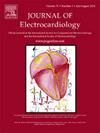梗死后外侧延伸-布罗迪效应还是支架血栓形成?
IF 1.3
4区 医学
Q3 CARDIAC & CARDIOVASCULAR SYSTEMS
引用次数: 0
摘要
对于st段抬高型心肌梗死患者刚接受左前降支支架治疗,特别是st段再次上升并延伸至外侧心前导联时,是否需要重新研究是一个常见的难题。作为预防措施,这类患者经常进行重复冠状动脉造影,通常证实支架通畅。梗死后左心室扩张,受再灌注损伤影响,产生布罗迪效应,模拟侧梗死。腔内血容量的增加使心脏更具导电性,并呈放射状放大心电图信号。本文章由计算机程序翻译,如有差异,请以英文原文为准。
Post-infarct lateral extension—Brody effect or stent thrombosis?
It is a common dilemma in determining whether to restudy a patient who has just received a stent in the left anterior descending artery for an anterior ST-elevation myocardial infarction, particularly when the ST-segments rise again and extend to lateral precordial leads. As a precaution, such patients frequently undergo repeat coronary angiography, which usually confirms stent patency. It appears that a dilated post-infarct left ventricle, affected by reperfusion injury, produces a Brody effect that mimics lateral infarction. The increase in intracavity blood volume renders the heart more electrically conductive and radially amplifies electrocardiographic signals.
求助全文
通过发布文献求助,成功后即可免费获取论文全文。
去求助
来源期刊

Journal of electrocardiology
医学-心血管系统
CiteScore
2.70
自引率
7.70%
发文量
152
审稿时长
38 days
期刊介绍:
The Journal of Electrocardiology is devoted exclusively to clinical and experimental studies of the electrical activities of the heart. It seeks to contribute significantly to the accuracy of diagnosis and prognosis and the effective treatment, prevention, or delay of heart disease. Editorial contents include electrocardiography, vectorcardiography, arrhythmias, membrane action potential, cardiac pacing, monitoring defibrillation, instrumentation, drug effects, and computer applications.
 求助内容:
求助内容: 应助结果提醒方式:
应助结果提醒方式:


